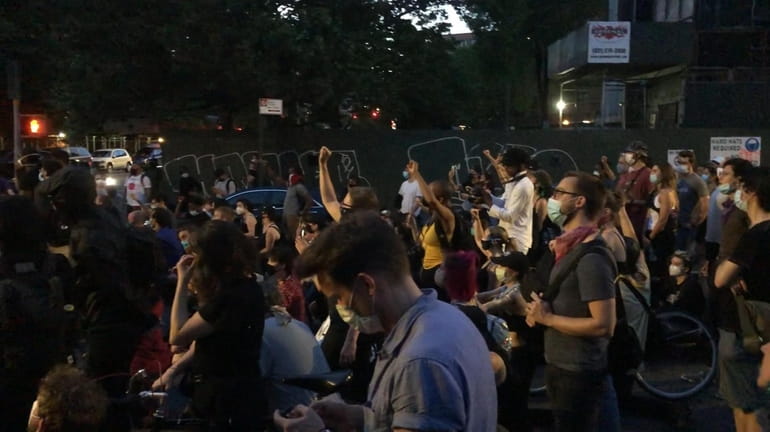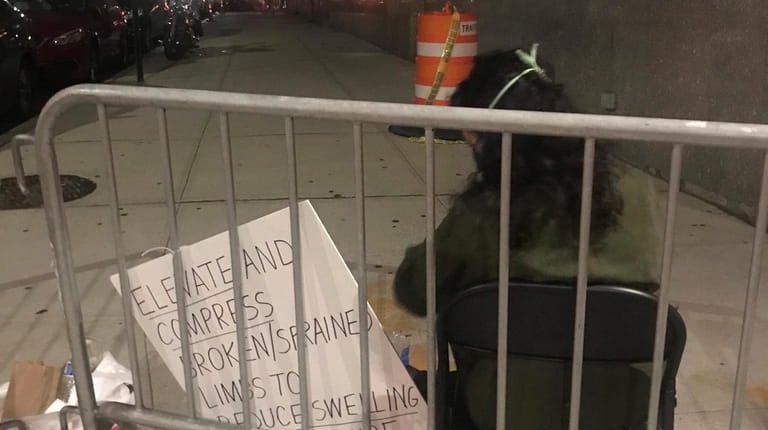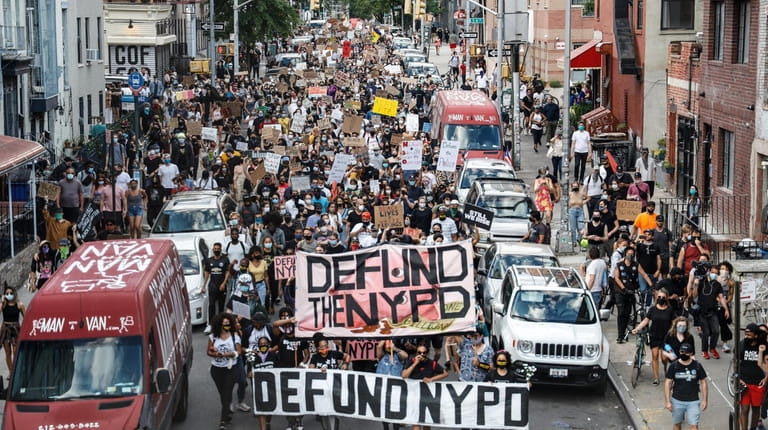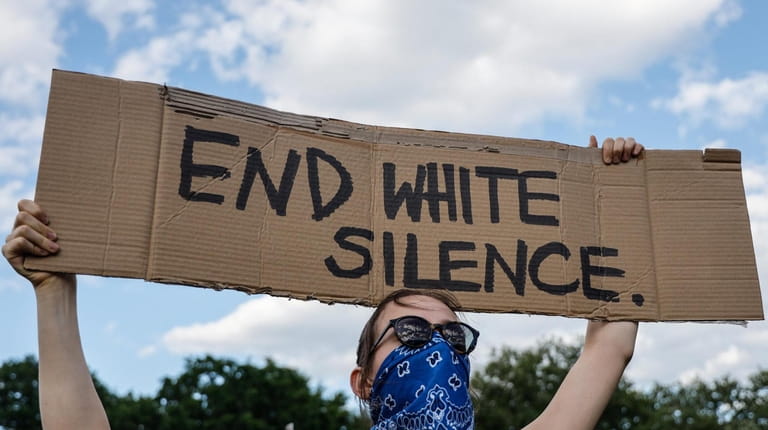As NYC curfew lifts a day early, nighttime protests continue

This story was reported by Matthew Chayes, Vera Chinese, Michael O'Keeffe and Ted Phillips. It was written by Chayes.
Mayor Bill de Blasio on Sunday credited an end to looting, violence and attacks on cops as reasons he lifted New York City’s six-night curfew a day early. Nonviolent protests during daytime Sunday continued into the night, now unencumbered by the 8 p.m. curfew and the direct threat of an NYPD shutdown.
Under de Blasio’s executive order, the curfew started June 1 and was to continue until Monday at 5 a.m.
“There had to be a commitment to getting us past the attacks on people and property — getting us past the efforts to incite violence, getting us past the attacks on police officers — to peaceful protest. And that is what was achieved in the course of the week,” de Blasio said Sunday at his daily news conference. NYPD on Monday said there were no arrests overnight.
“It’s an open question right now,” the mayor said, whether there still would be street closures in Manhattan south of 96th Street Sunday into Monday, as have been in place during the curfew.
Freddi Goldstein, a spokeswoman for de Blasio, said Sunday night that city streets are open.
The curfew was the first imposed by the city since 1943, when the shooting and rumored killing of a black soldier by a white officer sparked rioting in Harlem.
In Manhattan, protesters — some large groups, others smaller than previous nights — continued marching late Sunday. In Brooklyn, several previous demonstration hot spots were bereft of demonstrators — but hundreds of officers stood around waiting in case. Last week, the NYPD had doubled, to 8,000, the number of police on duty citywide to handle the widespread protests and looting.
Earlier Sunday night, about a 1,000 protesters marched near New York City Hall, passing through Chelsea to Union Square. Their route included SoHo and the Old Tweed Courthouse on Chambers Street.
Led by a vanguard of about four dozen cyclists the peaceful marchers chanted “No Justice No Peace” and “What’s his Name? George Floyd” while being trailed by more than half a dozen marked and unmarked police vehicles with lights flashing.
Police in riot gear lined sections of Broadway in SoHo as the group passed plywood boarded up shops in a neighborhood that saw looting last week. One police officer raised her fist in the air drawing cheers from the protesters.
Bearing signs with slogans like “All we ever wanted was to live” and “Arrest the Cops,” the group was shadowed by police walking on the sidewalk.
Along the Brooklyn Bridge on ramp, which the NYPD had shut down several times over the past week to stop demonstrators from crossing into Manhattan, traffic whooshed by as police in a caravan of unmarked vehicles straddled a concrete barrier, ate snacks and used their smartphones.
At the Barclays Center, site of earlier use of batons and pepper spray by officers, no protesters were there Sunday night, but extensive fencing remained, and the streets and sidewalks near the 78th Precinct were closed to the public. An NYPD helicopter had earlier in the night hovered above Brooklyn neighborhoods near Barclays Center, from which marches radiated throughout the day.

A "jail support" stand outside Brooklyn Criminal Court on Sunday night. Credit: Newsday / Matt Chayes
And at Brooklyn Criminal Court, where arrested protesters have been brought for processing and some freed, a “jail support” stand was open to distribute water, food, and help to get home or emergency medical treatment for those just let out.
“ELEVATE AND COMPRESS BROKEN/STRAINED LIMBS TO REDUCE SWELLING,” a handwritten sign there said. “PUT PRESSURE ON BLEEDING AREAS.”
Under the jail-support volunteer’s chair: a copy of the book “The End of Policing.”
De Blasio had promised Friday to release figures on how many arrestees had been injured in confrontations with the police but had not as of Sunday night.
A large group had gathered in Times Square Sunday afternoon where they listened to speakers and chanted protest slogans but otherwise rallied peacefully as police officers looked on. But at 6 p.m., the tourism hot spot had emptied of protesters. Police officers stood behind metal barriers at 42nd Street.

Protesters march Sunday on Driggs Avenue in Williamsburg. Credit: Jeffrey Basinger
In the Williamsburg section of Brooklyn, a large group of protesters, demanding the defunding of the NYPD, made their way along Driggs Avenue during the day.
The group of several hundred eventually arrived at McCarren Park where they continued a "Defund the Police Party!" event.

A woman uses a homemade sign to get her message out during a Sunday protest at McCarren Park in Williamsburg. Credit: Jeffrey Basinger
Protests and some rioting have swept the country since late last month, when outrage spread over the death of George Floyd — captured on cellphone video — in Minneapolis May 25 after an officer there knelt on his neck for more than eight minutes.
For the past four or five days, 10 separate groups have marched in different parts of the city, according to NYPD Deputy Commissioner John Miller, who was with the NYPD entourage for part of Thursday and Saturday nights. On Saturday, he joined officers trailing a group that began in the East Village and zigzagged downtown and finally to Herald Square.
On Saturday, tens of thousands of people protested, de Blasio said. There were four arrests and 24 summonses issued, according to the mayor. That’s far fewer than the nearly 700 arrested Monday. Viral videos began spreading of NYPD officers deploying batons, pepper spray and other physical force, including against nonviolent demonstrators and without warning.
De Blasio promised last weekend to investigate.
The NYPD said Sunday night they could not immediately provide updated arrest numbers for Sunday.
Deputy Mayor J. Phil Thompson said Sunday that the administration’s probe would scrutinize both police behavior “as well as looking into protesters that damaged property or did other things that have nothing to do with legitimate protest.”
De Blasio said Sunday the NYPD has seen dwindling property damage and looting that were both widespread last week and hit stores and businesses, including in some of the city’s more high-end shopping areas.
“If the question was stopping loss of life. stopping serious injury, stopping attacks on property, as I keep saying, keeping the National Guard out of New York City, yes, it was an effective strategy,” he said.
He added of the curfew: “I hope it never comes back. I have no intention to ever bring it back.”
De Blasio said the city would make a number of policy changes in the short term to address policing issues:
- Shifting money from the NYPD to youth programs and social services. He said the dollar figure was subject to negotiation with the City Council but would be finalized in time for the municipal budget, which is due at the end of June by law.
- A speedier disciplinary process for NYPD officers accused of misconduct. He did not elaborate.
- The removal of street vendor enforcement duties from the NYPD to a civilian agency.
De Blasio promised more changes were to come. Asked whether he expects resistance by the city’s police labor unions, he said, “if they want to fight, we’ll fight.”
“I don’t want to stereotype anyone, but I will say a blunt truth as a broad statement of fact, and I’ve been working on this for 30 years,” he said. “Police unions have held back progress in New York City and New York State, period.”
Lifting the curfew early came as New York City prepares to begin Phase 1 of its reopening Monday after a lockdown of more than two months due to the coronavirus pandemic.
De Blasio and his wife, Chirlane McCray, who joined his news conference Sunday, noted that their own daughter had been arrested during the protests.
“Apparently, you gave birth to one of those protesters,” de Blasio said to McCray.
“Absolutely,” she said. “One of those protesters was my child, and I’m very proud, very proud.”
Asked whether protesters would now be allowed to march all night if they wanted, de Blasio said: “In principle, yeah, if peaceful protesters go on quite a while as they have for nights and nights and they do not cause violence or undue disruption, yes, of course they’ll be allowed to keep going.”
Feral cat found with rabies . . . Piano Man's last show . . . Travel to Block Island . . . Olympics opening ceremony
Feral cat found with rabies . . . Piano Man's last show . . . Travel to Block Island . . . Olympics opening ceremony
